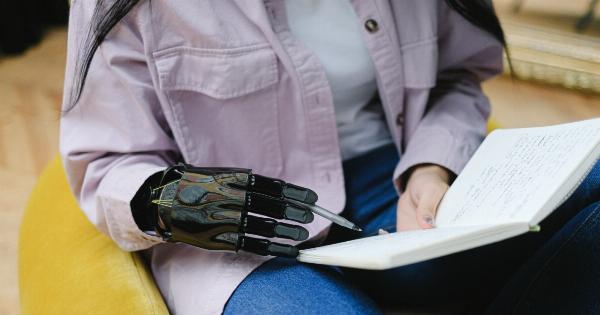In recent years, rapid advancements in technology have revolutionized various aspects of healthcare. From innovative diagnostic tools to robotic surgical procedures, the medical field has witnessed remarkable developments.
One such groundbreaking advancement is the emergence of futuristic hand technology that responds to a patient’s thoughts.
Understanding Futuristic Hand Technology
Futuristic hand technology is a remarkable scientific achievement that allows individuals with physical disabilities to regain control of their hands by simply using their thoughts.
This technology utilizes highly sophisticated brain-computer interfaces (BCIs) that establish a direct connection between the brain and a robotic hand.
The functionality of this technology relies on the principles of neuroplasticity, which refers to the brain’s ability to reorganize itself by forming new neural connections.
By harnessing this neuroplasticity, researchers have been able to develop neural interfaces that interpret and transmit signals from the brain to robotic hands.
How Futuristic Hand Technology Works
The underlying principle behind futuristic hand technology is the extraction of neural signals from an individual’s brain.
This is achieved through the use of implantable devices that are embedded in the brain’s motor cortex, responsible for controlling voluntary movements.
These implantable devices, often referred to as neural implants, consist of arrays of microscopic electrodes that penetrate the surface of the brain.
These electrodes are capable of capturing electrical signals generated by the neurons in the motor cortex during movement planning and execution.
The captured neural signals are then converted into digital information by specialized algorithms.
These algorithms can effectively interpret the patterns and frequencies of the electrical signals, deciphering the intended movement commands from the brain.
Once the desired movement commands are decoded, they are transmitted wirelessly to a robotic hand.
The robotic hand accurately mimics the intended hand movements, allowing the user to interact with the environment, grasp objects, and perform delicate tasks with precision.
Applications in Medicine
Futuristic hand technology holds immense potential within the medical field. It offers groundbreaking solutions for individuals who have lost the use of their hands due to conditions such as spinal cord injuries, stroke, or amputation.
One of the primary applications of this technology is in the field of neurorehabilitation. By utilizing futuristic hand technology, patients with physical disabilities can undergo intensive therapy aimed at restoring hand function.
The brain’s ability to form new connections enables individuals to gradually regain control over their paralyzed or prosthetic hands.
Additionally, this technology paves the way for more sophisticated prosthetic limbs. By seamlessly integrating with the wearer’s intentions, futuristic hand technology allows for a more intuitive and natural control over robotic limbs.
This significantly enhances the quality of life for individuals with limb loss, enabling them to perform a wide range of everyday tasks with relative ease.
Beyond rehabilitation and prosthetics, futuristic hand technology has potential applications in the field of neuroscience research.
By studying the neural signals associated with hand movements, researchers strive to gain a deeper understanding of the brain’s intricacies. This knowledge could lead to further advancements in neurology and contribute to the development of innovative therapies for neurological disorders.
Challenges and Future Developments
While futuristic hand technology presents extraordinary possibilities, it also comes with its share of challenges. One major hurdle is the long-term stability of neural implants within the brain.
Over time, the body’s immune response can cause inflammation around the implants, leading to deterioration in their performance.
Researchers are continuously exploring ways to enhance the biocompatibility of neural implants and develop more durable materials that minimize the risk of immune reactions.
Additionally, efforts are underway to make the surgical implantation of neural implants a safer and less invasive procedure.
Another area of focus is the improvement of the decoding algorithms used in futuristic hand technology.
Advancements in machine learning and artificial intelligence are expected to enhance the accuracy and efficiency of decoding neural signals, enabling more precise and complex hand movements.
Furthermore, researchers are working on developing sensory feedback systems for futuristic hand technology.
Integrating sensors into the robotic hand that can transmit tactile information to the user’s brain would enhance the sense of touch and grip control, further improving the usability and functionality of these technologies.
Ethical Considerations
As with any emerging technology, futuristic hand technology raises important ethical considerations.
The use of neural implants, particularly those that require surgical implantation, raises concerns over the invasiveness of the procedure and its potential risks.
Additionally, there are ethical considerations surrounding data privacy and security. Given that futuristic hand technology relies on capturing and interpreting brain signals, it is crucial to ensure the protection of individuals’ neural data.
This entails implementing robust cybersecurity measures and establishing clear guidelines for data usage and storage.
Furthermore, ethical discussions are essential regarding the equitable distribution and accessibility of futuristic hand technology.
As it is a highly advanced and costly technology, ensuring equal opportunities for access and affordability is crucial to avoid exacerbating existing social inequalities.
The Future of Hand Technology
Futuristic hand technology holds immense promise for revolutionizing the lives of individuals with physical disabilities.
The continuous advancements being made in the field of neurology and robotics are driving the development of increasingly sophisticated neural interfaces and robotic hands.
In the future, we can expect to see smaller, more durable neural implants that can be implanted with minimal invasiveness. Decoding algorithms will become more efficient, enabling precise control over fine motor skills.
Sensory feedback systems will enhance the user’s experience, providing a more realistic sense of touch and grip.
Ultimately, futuristic hand technology has the potential to transform the way we perceive and interact with the world.
By bridging the gap between the human brain and robotic hands, this technology empowers individuals with physical disabilities, offering them a new lease on life.






























